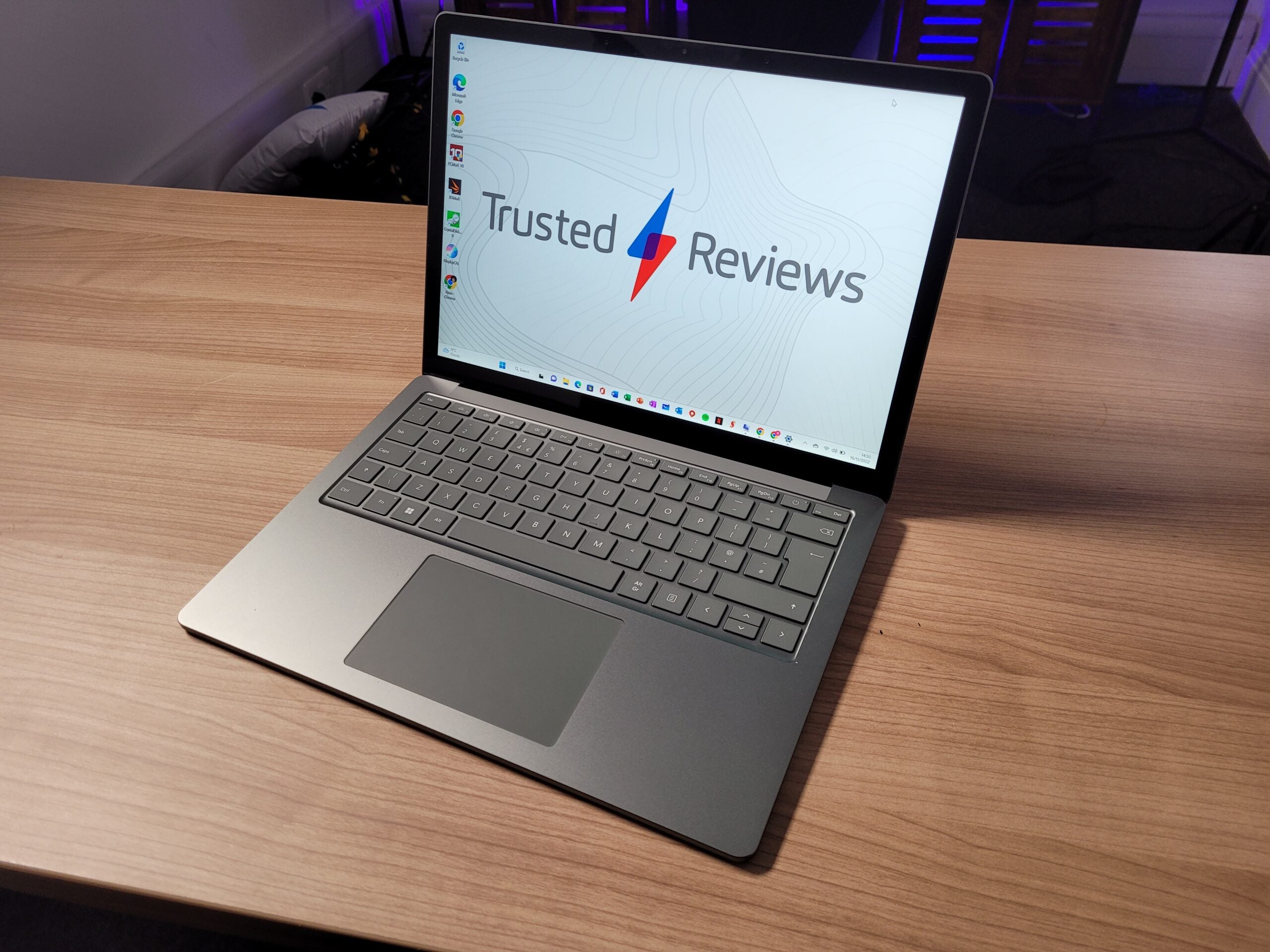The Microsoft Surface Laptop 5 has seen minor upgrades, with a slightly faster processor and Thunderbolt 4 connectivity. But with an outdated design and underwhelming performance, it’s difficult to understand why anyone would be willing to purchase this laptop instead of a MacBook Air or Dell XPS 13.
Pros
- Slim and portable design
- Finally has Thunderbolt 4 connectivity
- High resolution display
- Good battery life
Cons
- Design looks severely outdated
- Slower performance than competition
- No fingerprint sensor
- Lacks a killer feature
Availability
- UKRRP: £999
- USARRP: $999.99
-
Intel Core 12th Generation processor:The Microsoft Surface Laptop 5 is powered by the latest generation of Intel processors. -
Thunderbolt 4 support:Microsoft has finally enabled Thunderbolt 4 support, enabling quicker data transfer speeds and the ability to connect up to a wider range of external devices. -
Touchscreen:The Surface Laptop 5 has a touchscreen, allowing you to navigate webpages with prods, pinches and swipes.
Introduction
When Microsoft first launched the Surface Laptop range back in 2017, it was a revelation. With specs to rival a MacBook Air and a lightweight design ahead of its time, the Surface Laptop was one of the very best laptops you could buy.
Five years later, Microsoft is still relying on the same blueprint; the processor has been updated and Thunderbolt 4 support finally added, but this is otherwise a very similar laptop, especially in terms of design.
While other laptop manufacturers have slimmed down the screen bezel, added OLED panels and chucked in fingerprint scanners, the Surface Laptop range has seen little innovation.
The Surface Laptop 5 is still a fine laptop, capable of serving anyone who needs a portable for productivity workloads, but there are far more exciting alternatives at the same price.
Design
- Thick screen bezel looks incredibly outdated
- Thunderbolt 4 boosts connectivity options
- Keyboard feels great to use
It was just over a year ago when I reviewed Microsoft’s Surface Laptop 4 and expressed my concerns that it looked outdated. And now we’re in 2022 with the newly launched Surface Laptop 5, and Microsoft has once again refused to update the design. I feel like I’m getting déjà vu.
I don’t mind the lack of updates to the laptop’s deck. It still looks great, with options for shiny metal or textured fabric Alcantara. Both the 13.5-inch and 15-inch models have a slender frame too, making it easy to slot inside a bag.
But draw your eyes to the laptop’s display, and you’ll notice a thick black bezel that surrounds the screen. It looks ugly, especially compared to the Dell XPS 13 Plus and the hardly visible bezel. It’s also needlessly hogging up precious screen space.
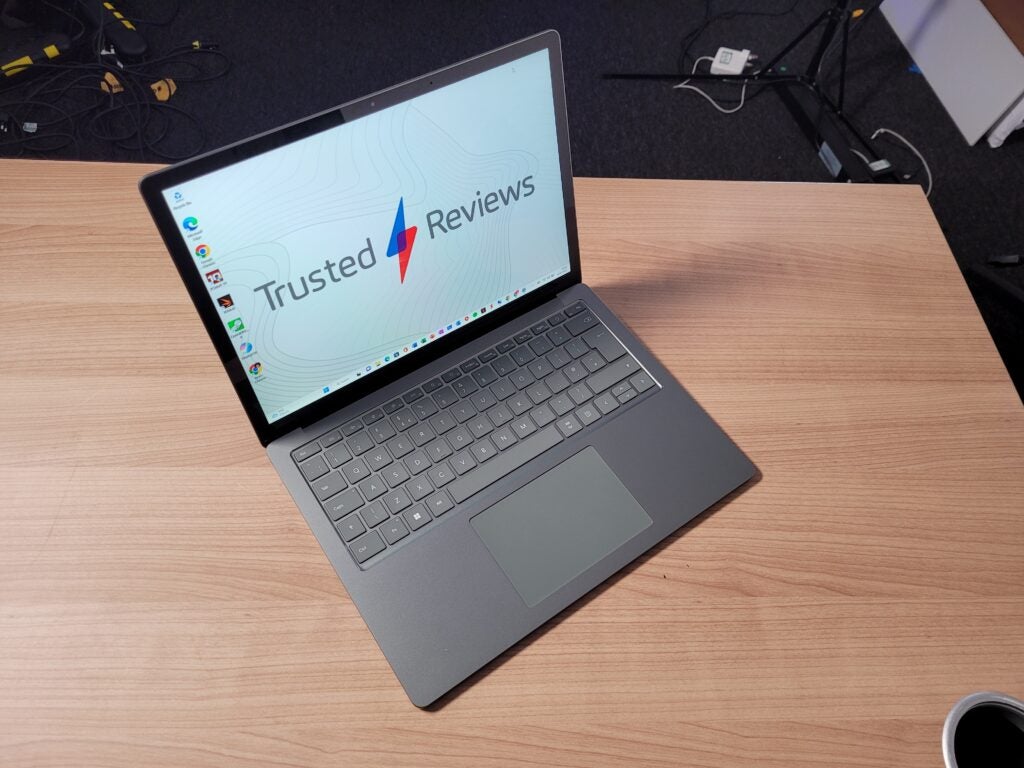
The only visible alteration Microsoft has bothered to make to the laptop is to introduce a new colour, which is the Sage edition I have here. It’s a nice alternative to the Platinum, Black and Sandstone colours, but I am disappointed that Ice Blue is no longer available.
Microsoft has finally upgraded the Surface Laptop’s USB port with support for Thunderbolt 4. This not only speeds up the time it takes to transfer data to and from the laptop, but also allows for more versatility when connecting external monitors. It’s a great upgrade for the Surface Laptop 5, finally putting it on equal footing with other premium ultrabooks.
That said, the selection of ports is still fairly poor, with just a USB-C, USB-A and headphone jack found on the left rim. The Surface Connect port on the right-hand side is used for charging, although it takes up too much space where an extra Thunderbolt 4 connection would be more useful.
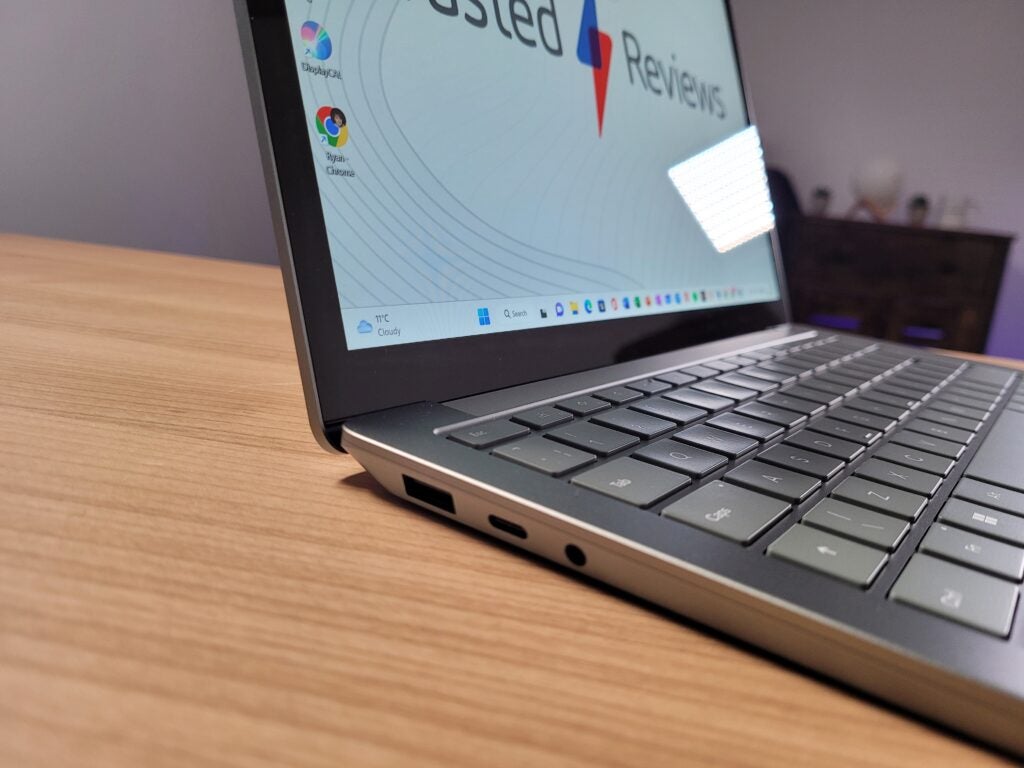
Microsoft says it wants to keep the Surface Connect port to ensure compatibility with its own accessories, while ensuring a magnetic (although flimsy in my experience) connection when charging. I’m not convinced by that reasoning.
I’m a big fan of the keyboard, with audible clicks providing satisfying feedback. The laptop has a sturdy frame below too, so you don’t need to worry about the deck flexing underneath your prods.
It’s a shame there’s still no fingerprint scanner here, as it’s become a default feature for the vast majority of premium ultrabooks, however you can at least sign into your laptop via facial recognition (via Windows Hello) if you can’t be bothered typing in passwords.
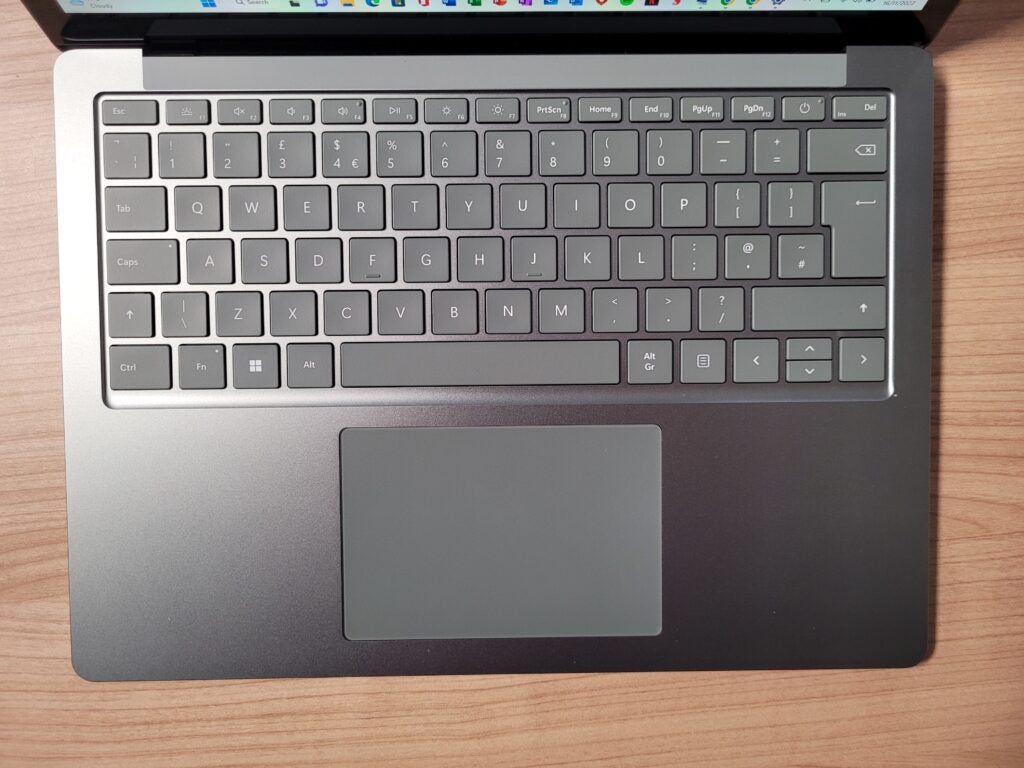
The webcam has a 720p resolution; that isn’t the sharpest, and means video feeds look a little fuzzy and pixelated. It’s perfectly fine for Teams meetings for work, but you’ll need an external camera if you want high-grade video quality for YouTube.
The laptop’s trackpad is large, smooth and responsive, which is the holy trinity. I would have thought Microsoft would have been tempted to use a haptic feedback trackpad following the launch of the Surface Laptop Studio, but I’m happy enough to stick with a physical one for the time being.
Screen
- Available with a 13.5-inch or 15-inch display
- High-resolution display ensured detailed video
- Colours are not accurate enough for professional work
The Microsoft Surface Laptop 5 is available with either a 13.5-inch or 15-inch screen, both featuring touch input and a 3:2 aspect ratio to optimise the display for websites and social media rather than video.
Picture quality is great too, with a Quad HD resolution ensuring on-screen photos and videos look sharp and detailed. Colours certainly looked bold when watching the Black Panther: Wakanda Forever trailer, although I did have a little trouble seeing much detail during darker scenes set at night.

By using a colorimeter, I was able to get a more in-depth look at the screen quality. I recorded a brightness of 398 nits that’s considerably brighter than the average laptop, and a mediocre contrast of 1264:1. Tests backed up my concerns about this laptop’s ability at showing high detail in dark scenes (so watch out House of the Dragon fans) although it was still comfortably competent enough for video streaming.
It’s a shame that Microsoft hasn’t upgraded the laptop range with an OLED panel yet, which would improve the display’s contrast and vibrancy – that said, such an addition would have likely driven up the cost.
My only major concern for the Microsoft Surface Laptop 5 when it comes to screen quality is the colour coverage. With a 61.4% coverage of Adobe RGB and 63.1% coverage of DCI-P3, this laptop is far from an ideal option for colour-sensitive workloads such as editing photos and videos. You’re better off with a MacBook Pro if that’s an area of priority.
I was pleased to hear how loud the speakers can get, while still being capable of retaining detail. I could happily watch a movie or listen to Spotify with this laptop without bothering with headphones.
Performance
- Updated with a 12th Gen Intel Core processor
- Still not as fast as the competition
- Low base storage and sluggish SSD speeds
The processor is the biggest upgrade for the Microsoft Surface Laptop 5 compared to its predecessor, although I’m still not hugely impressed by the chip’s performance.
The Microsoft Surface Laptop 5 is powered by a 12th Generation Intel Core i7-1255U processor. It’s a clear improvement on the Surface Laptop 4, but the U-Series CPU that Microsoft has opted for doesn’t compare well to the more powerful P-Series processor of the Dell XPS 13 Plus. Even the M1-powered MacBook Air posted superior performance scores, despite launching two years earlier.
| Surface Laptop 5 | Surface Laptop 4 | Dell XPS 13 Plus | MacBook Air | |
| CPU | Intel Core i7-1255U | Intel Core i5-1135G7 | Intel Core i7-1260P | Apple M1 |
| Geekbench 5 single/multi | 1206 / 6649 | 1307 / 4844 | 1467 / 7155 | 1731 / 7308 |
| PCMark 10 | 4107 | 4088 | 5211 | N/A |
There’s no doubt you can find more powerful laptops elsewhere without spending more, but that doesn’t mean Microsoft’s laptop is slow. It’s still comfortably fast enough to hop between web pages without slowdown, while even having multiple apps running in the background. You won’t need a faster machine for basic productivity tasks.
The underwhelming benchmark scores are only really problematic if you need a high-performance machine for the likes of content creation. The Surface Laptop 5 is no competitor to the MacBook Pro, or indeed the Surface Laptop Studio, especially since it lacks a discrete GPU.
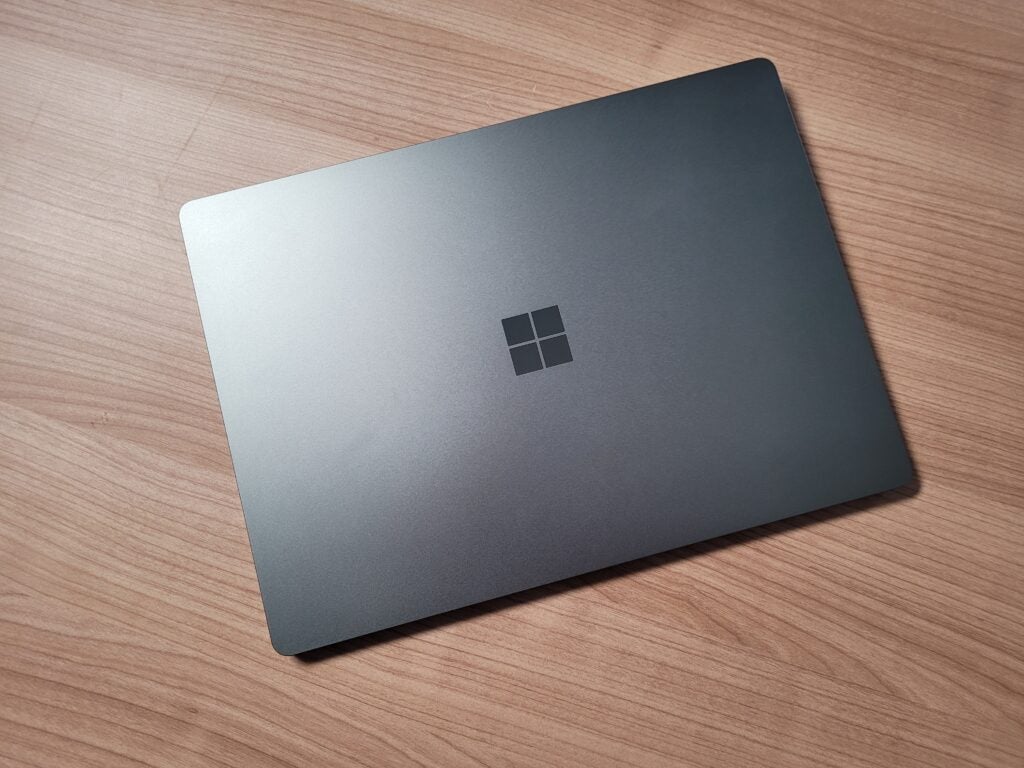
The base storage option for the Surface Laptop 5 only packs a 256GB SSD. I really don’t think that’s enough space for most people these days, unless you rely heavily on the cloud. Fortunately, you can upgrade to a 512GB model (or 1TB model if you opt for the 15-inch version), although it is fairly costly to do so.
I was really disappointed by the laptop’s SSD speeds. With read and write speeds of 3560 MB/s and 2483 MB/s respectively, other laptops such as the Dell XPS 13 Plus are twice as fast when saving or loading data to the physical drive. This can affect multiple workloads, including booting up the laptop or even opening an app such as Spotify or Netflix.
Battery life
- Lasted just shy of 13 hours during battery test
- Can be recharged to 100% in 90 minutes
I’ve been scratching my head wondering why Microsoft opted for such a low-powered Intel processor. Maybe it was to maximise battery life?
During our battery tests, where we dial down the brightness to 150 nits and use PCMark 10 to simulate office-based workloads, the Microsoft Surface Laptop 5 lasted for 12 hours and 43 minutes. That’s great stamina, with the average laptop only lasting around 10 hours.
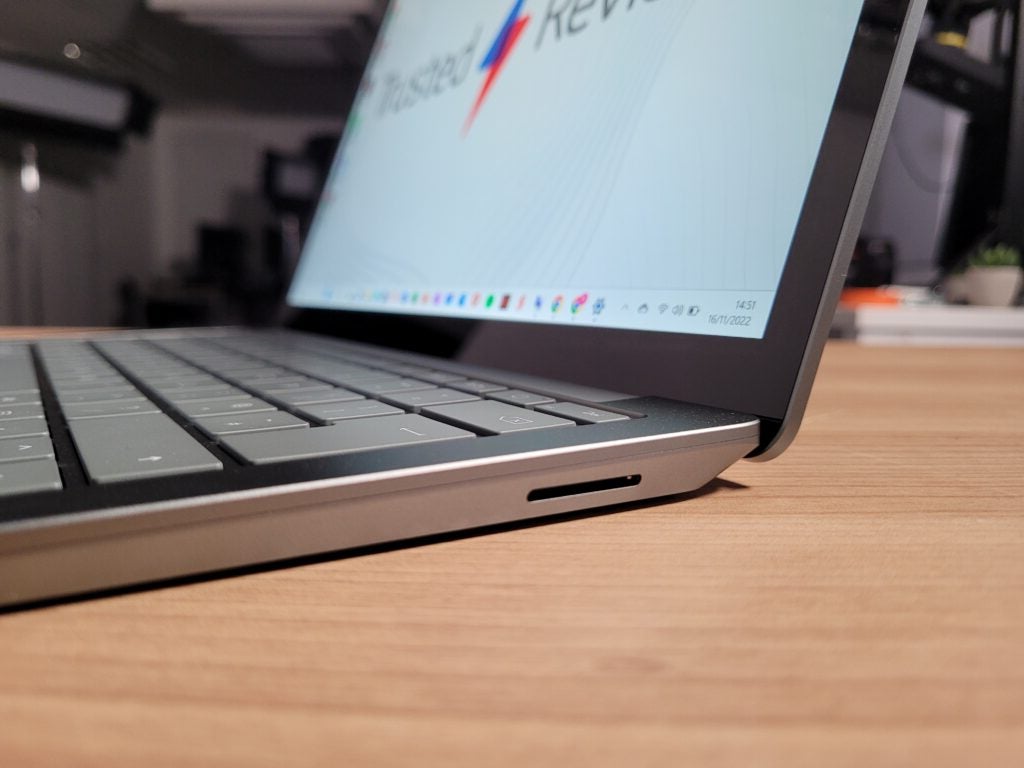
But is that battery life good enough to make up for the loss of performance? I’m not convinced, especially when the more powerful MacBook Air can last for nearly 14 hours.
When recharging the laptop, it only took 45 minutes to fill up the battery halfway, and 90 minutes to completely replenish the battery. That’s really useful if you need a quick top up before rushing out to work.
Latest deals
Should you buy it?
You’re loyal to the Surface brand: Judged independently, the Microsoft Surface Laptop 5 is a decent laptop. It’s portable, offers a decent performance and has a nice screen for streaming video. However, there are better alternatives available at the same price, so you really need to be committed to the Surface brand to make it worthwhile.
You’re happy to switch over to macOS: The M1-powered MacBook Air is available at the same price, and is a far better laptop. It’s faster, has a more modern design and a longer battery life. Unless you really dislike macOS or there’s a significant discount, I don’t see why you’d pick the Surface Laptop 5 over the MacBook Air.
Final Thoughts
It’s difficult to think of a reason why anyone should purchase the Microsoft Surface Laptop 5. It’s certainly not a bad laptop when judged independently, with a portable design, modern processor and high-resolution display. But there isn’t anything here to justify a purchase over a MacBook Air, Dell XPS 13 Plus or any other modern ultrabook.
It has a seriously outdated design, a poor port selection and lacks a killer feature such as an OLED screen, high-end chip or even a fingerprint sensor. Even a cheaper price would have made a big difference.
It’s great to finally see Microsoft add Thunderbolt 4 connectivity to the Surface Laptop range, but it’s simply not enough of an upgrade to make this laptop competitive. As a result, I can only really recommend this laptop if it gets a discount during a sale or if you’re a loyalist to the Microsoft Surface brand.
How we test
Every laptop we review goes through a series of uniform checks designed to gauge key things including build quality, performance, screen quality and battery life.
These include formal synthetic benchmarks and scripted tests, plus a series of real-world checks, such as how well it runs the most frequently used apps.
We also make sure to use every laptop we review as our primary device for at least a week to ensure our review is as accurate as possible.
Spent a week with the laptop.
Used benchmark tests and real-time use to judge performance.
Used professional equipment to test the screen quality.
Used benchmark software to test the battery life.
FAQs
A Surface Laptop is a traditional laptop, with a proper keyboard that can’t be detached. The Surface Pro range is actually made of tablets instead, but can be turned into a makeshift laptop by attaching a separate keyboard accessory.
Compared to the competition, it has an outdated design, slower performance and poor connectivity options.
Trusted Reviews test data
Sustainability
TrustedReviews’ holds the fact that global warming is not a myth as a core value and will continuously endeavor to help protect our planet from harm in its business practices.
As part of this mission, whenever we review a product we send the company a series of questions to help us gauge and make transparent the impact the device has on the environment.
We currently haven’t received answers to the questions on this product, but will update this page the moment we do. You can see a detailed breakdown of the questions we ask and why in our sustainability info page.
Jargon buster
SSD
Known as Solid State Drive, this is a faster form of a memory than a standard hard drive. Results in faster loading times and more ambitious games.
GPU
The graphics processing unit is designed to render graphics, which is particularly important for gaming, creating 3D models and editing video.
The Microsoft Surface Laptop 5 has seen minor upgrades, with a slightly faster processor and Thunderbolt 4 connectivity. But with an outdated design and underwhelming performance, it’s difficult to understand why anyone would be willing to purchase this laptop instead of a MacBook Air or Dell XPS 13.
Pros
- Slim and portable design
- Finally has Thunderbolt 4 connectivity
- High resolution display
- Good battery life
Cons
- Design looks severely outdated
- Slower performance than competition
- No fingerprint sensor
- Lacks a killer feature
Availability
- UKRRP: £999
- USARRP: $999.99
-
Intel Core 12th Generation processor:The Microsoft Surface Laptop 5 is powered by the latest generation of Intel processors. -
Thunderbolt 4 support:Microsoft has finally enabled Thunderbolt 4 support, enabling quicker data transfer speeds and the ability to connect up to a wider range of external devices. -
Touchscreen:The Surface Laptop 5 has a touchscreen, allowing you to navigate webpages with prods, pinches and swipes.
Introduction
When Microsoft first launched the Surface Laptop range back in 2017, it was a revelation. With specs to rival a MacBook Air and a lightweight design ahead of its time, the Surface Laptop was one of the very best laptops you could buy.
Five years later, Microsoft is still relying on the same blueprint; the processor has been updated and Thunderbolt 4 support finally added, but this is otherwise a very similar laptop, especially in terms of design.
While other laptop manufacturers have slimmed down the screen bezel, added OLED panels and chucked in fingerprint scanners, the Surface Laptop range has seen little innovation.
The Surface Laptop 5 is still a fine laptop, capable of serving anyone who needs a portable for productivity workloads, but there are far more exciting alternatives at the same price.
Design
- Thick screen bezel looks incredibly outdated
- Thunderbolt 4 boosts connectivity options
- Keyboard feels great to use
It was just over a year ago when I reviewed Microsoft’s Surface Laptop 4 and expressed my concerns that it looked outdated. And now we’re in 2022 with the newly launched Surface Laptop 5, and Microsoft has once again refused to update the design. I feel like I’m getting déjà vu.
I don’t mind the lack of updates to the laptop’s deck. It still looks great, with options for shiny metal or textured fabric Alcantara. Both the 13.5-inch and 15-inch models have a slender frame too, making it easy to slot inside a bag.
But draw your eyes to the laptop’s display, and you’ll notice a thick black bezel that surrounds the screen. It looks ugly, especially compared to the Dell XPS 13 Plus and the hardly visible bezel. It’s also needlessly hogging up precious screen space.

The only visible alteration Microsoft has bothered to make to the laptop is to introduce a new colour, which is the Sage edition I have here. It’s a nice alternative to the Platinum, Black and Sandstone colours, but I am disappointed that Ice Blue is no longer available.
Microsoft has finally upgraded the Surface Laptop’s USB port with support for Thunderbolt 4. This not only speeds up the time it takes to transfer data to and from the laptop, but also allows for more versatility when connecting external monitors. It’s a great upgrade for the Surface Laptop 5, finally putting it on equal footing with other premium ultrabooks.
That said, the selection of ports is still fairly poor, with just a USB-C, USB-A and headphone jack found on the left rim. The Surface Connect port on the right-hand side is used for charging, although it takes up too much space where an extra Thunderbolt 4 connection would be more useful.

Microsoft says it wants to keep the Surface Connect port to ensure compatibility with its own accessories, while ensuring a magnetic (although flimsy in my experience) connection when charging. I’m not convinced by that reasoning.
I’m a big fan of the keyboard, with audible clicks providing satisfying feedback. The laptop has a sturdy frame below too, so you don’t need to worry about the deck flexing underneath your prods.
It’s a shame there’s still no fingerprint scanner here, as it’s become a default feature for the vast majority of premium ultrabooks, however you can at least sign into your laptop via facial recognition (via Windows Hello) if you can’t be bothered typing in passwords.

The webcam has a 720p resolution; that isn’t the sharpest, and means video feeds look a little fuzzy and pixelated. It’s perfectly fine for Teams meetings for work, but you’ll need an external camera if you want high-grade video quality for YouTube.
The laptop’s trackpad is large, smooth and responsive, which is the holy trinity. I would have thought Microsoft would have been tempted to use a haptic feedback trackpad following the launch of the Surface Laptop Studio, but I’m happy enough to stick with a physical one for the time being.
Screen
- Available with a 13.5-inch or 15-inch display
- High-resolution display ensured detailed video
- Colours are not accurate enough for professional work
The Microsoft Surface Laptop 5 is available with either a 13.5-inch or 15-inch screen, both featuring touch input and a 3:2 aspect ratio to optimise the display for websites and social media rather than video.
Picture quality is great too, with a Quad HD resolution ensuring on-screen photos and videos look sharp and detailed. Colours certainly looked bold when watching the Black Panther: Wakanda Forever trailer, although I did have a little trouble seeing much detail during darker scenes set at night.

By using a colorimeter, I was able to get a more in-depth look at the screen quality. I recorded a brightness of 398 nits that’s considerably brighter than the average laptop, and a mediocre contrast of 1264:1. Tests backed up my concerns about this laptop’s ability at showing high detail in dark scenes (so watch out House of the Dragon fans) although it was still comfortably competent enough for video streaming.
It’s a shame that Microsoft hasn’t upgraded the laptop range with an OLED panel yet, which would improve the display’s contrast and vibrancy – that said, such an addition would have likely driven up the cost.
My only major concern for the Microsoft Surface Laptop 5 when it comes to screen quality is the colour coverage. With a 61.4% coverage of Adobe RGB and 63.1% coverage of DCI-P3, this laptop is far from an ideal option for colour-sensitive workloads such as editing photos and videos. You’re better off with a MacBook Pro if that’s an area of priority.
I was pleased to hear how loud the speakers can get, while still being capable of retaining detail. I could happily watch a movie or listen to Spotify with this laptop without bothering with headphones.
Performance
- Updated with a 12th Gen Intel Core processor
- Still not as fast as the competition
- Low base storage and sluggish SSD speeds
The processor is the biggest upgrade for the Microsoft Surface Laptop 5 compared to its predecessor, although I’m still not hugely impressed by the chip’s performance.
The Microsoft Surface Laptop 5 is powered by a 12th Generation Intel Core i7-1255U processor. It’s a clear improvement on the Surface Laptop 4, but the U-Series CPU that Microsoft has opted for doesn’t compare well to the more powerful P-Series processor of the Dell XPS 13 Plus. Even the M1-powered MacBook Air posted superior performance scores, despite launching two years earlier.
| Surface Laptop 5 | Surface Laptop 4 | Dell XPS 13 Plus | MacBook Air | |
| CPU | Intel Core i7-1255U | Intel Core i5-1135G7 | Intel Core i7-1260P | Apple M1 |
| Geekbench 5 single/multi | 1206 / 6649 | 1307 / 4844 | 1467 / 7155 | 1731 / 7308 |
| PCMark 10 | 4107 | 4088 | 5211 | N/A |
There’s no doubt you can find more powerful laptops elsewhere without spending more, but that doesn’t mean Microsoft’s laptop is slow. It’s still comfortably fast enough to hop between web pages without slowdown, while even having multiple apps running in the background. You won’t need a faster machine for basic productivity tasks.
The underwhelming benchmark scores are only really problematic if you need a high-performance machine for the likes of content creation. The Surface Laptop 5 is no competitor to the MacBook Pro, or indeed the Surface Laptop Studio, especially since it lacks a discrete GPU.

The base storage option for the Surface Laptop 5 only packs a 256GB SSD. I really don’t think that’s enough space for most people these days, unless you rely heavily on the cloud. Fortunately, you can upgrade to a 512GB model (or 1TB model if you opt for the 15-inch version), although it is fairly costly to do so.
I was really disappointed by the laptop’s SSD speeds. With read and write speeds of 3560 MB/s and 2483 MB/s respectively, other laptops such as the Dell XPS 13 Plus are twice as fast when saving or loading data to the physical drive. This can affect multiple workloads, including booting up the laptop or even opening an app such as Spotify or Netflix.
Battery life
- Lasted just shy of 13 hours during battery test
- Can be recharged to 100% in 90 minutes
I’ve been scratching my head wondering why Microsoft opted for such a low-powered Intel processor. Maybe it was to maximise battery life?
During our battery tests, where we dial down the brightness to 150 nits and use PCMark 10 to simulate office-based workloads, the Microsoft Surface Laptop 5 lasted for 12 hours and 43 minutes. That’s great stamina, with the average laptop only lasting around 10 hours.

But is that battery life good enough to make up for the loss of performance? I’m not convinced, especially when the more powerful MacBook Air can last for nearly 14 hours.
When recharging the laptop, it only took 45 minutes to fill up the battery halfway, and 90 minutes to completely replenish the battery. That’s really useful if you need a quick top up before rushing out to work.
Latest deals
Should you buy it?
You’re loyal to the Surface brand: Judged independently, the Microsoft Surface Laptop 5 is a decent laptop. It’s portable, offers a decent performance and has a nice screen for streaming video. However, there are better alternatives available at the same price, so you really need to be committed to the Surface brand to make it worthwhile.
You’re happy to switch over to macOS: The M1-powered MacBook Air is available at the same price, and is a far better laptop. It’s faster, has a more modern design and a longer battery life. Unless you really dislike macOS or there’s a significant discount, I don’t see why you’d pick the Surface Laptop 5 over the MacBook Air.
Final Thoughts
It’s difficult to think of a reason why anyone should purchase the Microsoft Surface Laptop 5. It’s certainly not a bad laptop when judged independently, with a portable design, modern processor and high-resolution display. But there isn’t anything here to justify a purchase over a MacBook Air, Dell XPS 13 Plus or any other modern ultrabook.
It has a seriously outdated design, a poor port selection and lacks a killer feature such as an OLED screen, high-end chip or even a fingerprint sensor. Even a cheaper price would have made a big difference.
It’s great to finally see Microsoft add Thunderbolt 4 connectivity to the Surface Laptop range, but it’s simply not enough of an upgrade to make this laptop competitive. As a result, I can only really recommend this laptop if it gets a discount during a sale or if you’re a loyalist to the Microsoft Surface brand.
How we test
Every laptop we review goes through a series of uniform checks designed to gauge key things including build quality, performance, screen quality and battery life.
These include formal synthetic benchmarks and scripted tests, plus a series of real-world checks, such as how well it runs the most frequently used apps.
We also make sure to use every laptop we review as our primary device for at least a week to ensure our review is as accurate as possible.
Spent a week with the laptop.
Used benchmark tests and real-time use to judge performance.
Used professional equipment to test the screen quality.
Used benchmark software to test the battery life.
FAQs
A Surface Laptop is a traditional laptop, with a proper keyboard that can’t be detached. The Surface Pro range is actually made of tablets instead, but can be turned into a makeshift laptop by attaching a separate keyboard accessory.
Compared to the competition, it has an outdated design, slower performance and poor connectivity options.
Trusted Reviews test data
Sustainability
TrustedReviews’ holds the fact that global warming is not a myth as a core value and will continuously endeavor to help protect our planet from harm in its business practices.
As part of this mission, whenever we review a product we send the company a series of questions to help us gauge and make transparent the impact the device has on the environment.
We currently haven’t received answers to the questions on this product, but will update this page the moment we do. You can see a detailed breakdown of the questions we ask and why in our sustainability info page.
Jargon buster
SSD
Known as Solid State Drive, this is a faster form of a memory than a standard hard drive. Results in faster loading times and more ambitious games.
GPU
The graphics processing unit is designed to render graphics, which is particularly important for gaming, creating 3D models and editing video.


















